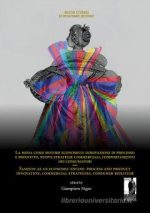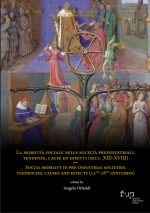Erik Aerts, Alternativo ma non arcaico, pp.1-4
Philippe Bernardi, Prolusione, pp.5-24
MECCANISMI PER L’UTILIZZO DI MEZZI DI SCAMBIO NON MONETARI / MECHANISMS FOR USING ALTERNATIVE CURRENCIES
Thomas Max Safley, Money and its alternatives in Early Modern extractive industry: The many media of exchange in mercury miningm, pp.27-45
Giulio Ongaro, Luca Mocarelli, In kind wages between city and countryside: Northern Italy in the Eighteenth Century, pp.47-76
Michela Barbot, Cedere dei beni al posto del denaro dovuto. La datio in solutum in Francia e Italia fra XVII e XVIII secolo, pp.77-92
Robert Braid, Alternative forms of remuneration at the Holy Spirit Hospital of Marseille in the Fourteenth century, pp.93-119
Thijs Lambrecht, Joke Verfaillie, Tom de Waele, Lords, Peasantries and the remuneration of labour services in the Southern Low Countries, 13th-18th centuries, pp.121-138
Natacha Coquery, Guerre, dirigisme, approvisionnement. Les marchandises de luxe, monnaie d’échanges alternative sous la Terreur, pp.139-169
Francine Michaud, Alternative currencies and quality of life in Late Thirteenth- and Fourteenth-century Marseille: Negotiating labour in times of turmoil, pp.171-189
LA DIFFUSIONE DEI MEZZI DI SCAMBIO NON MONETARI /THE DIFFUSION OF ALTERNATIVE CURRENCIES
Fabrizio Alias, Uso e diffusione della ‘moneta alternativa’ in Sardegna tra XI e XIV secolo, pp.193-218
Francesco Guidi Bruscoli, ‘Wherever they consider it more profitable, for cash, baratto or credit’. Florentine merchants and the export of silk cloth (15th-16th centuries), pp.219-235
Ludwig Pelzl, Jaco Zuijderduijn, Or do you prefer cash? Pensions in kind in pre-modern Germany and the Low Countries, pp.237-255
Jean-Luc de Meulemeester, Pierre-David Kusman, Honour, social capital and alternative currencies: the “leisting” custom in the cities of the Late Medieval Low Countries and Rhineland, pp.257-290
Matthieu Scherman, Les Salviati et le troc monétarisé: des pratiques courantes au XVe siècle entre la Méditerranée et le Nord-Ouest de l’Europe, pp.291-302
Anne Kucab, Les monnaies alternatives à Rouen à la fin du Moyen Âge, pp.303-321
NATURA DEI MEZZI DI SCAMBIO NON MONETARI / THE NATURE OF ALTERNATIVE CURRENCIES
Nenad Fejic, An apparent paradox: wool as an alternative currency for merchants and weavers in Dubrovnik (Ragusa) in the 15th century, pp.325-336
Lisa Caliste, Catherine Verna, Pratiques du troc, industries et stratégies individuelles (Lodévois et Vallespir, XVe siècle-vers 1550), pp.337-355
Rachele Scuro, Perle, gioie e pegni. Il ruolo dei preziosi nel mercato del credito e degli scambi nella Venezia cinquecentesca, pp.357-390
William Caferro, Alternate currencies, bills of exchange and warfare in Trecento Italy, pp.391-408
Corine Maitte, La part des anges? Les rémunérations en nature entre truck system et considération sociale, pp.409-429
Judicaël Petrowiste, Des poêles, des chaudrons et des couvertures. Payer son impôt par des objets dans le bourg de Najac (1258-1273), pp.431-451
USI DEI MEZZI DI SCAMBIO NON MONETARI / USES OF ALTERNATIVE CURRENCIES
Alexandra Sapoznik, Lluís Sales i Favà, Wax, cash and the mass. Making candles affordable in late medieval economies, pp.455-574
Tim Soens, Cécile Bruyet, Alternative Food Supplies, Alternative Currencies? Food deliveries by tenant farmers in the late medieval Low Countries, pp.475-504
Julie Claustre, Les monnaies alternatives à Paris au XVe siècle, d’après les transactions d’un atelier de couture, pp.505-518
Alejandra Irigoin, Respondentia: The alternative contract for global trade finance in the Early Modern period, pp.519-544
TAVOLA ROTONDA / ROUND TABLE
Philippe Bernardi, Tavola rotonda, pp.547-549
William Caferro, Roundtable comments, pp.551-555
Luca Mocarelli, Tavola rotonda, pp.557-566
Abstract, p. 567-580




